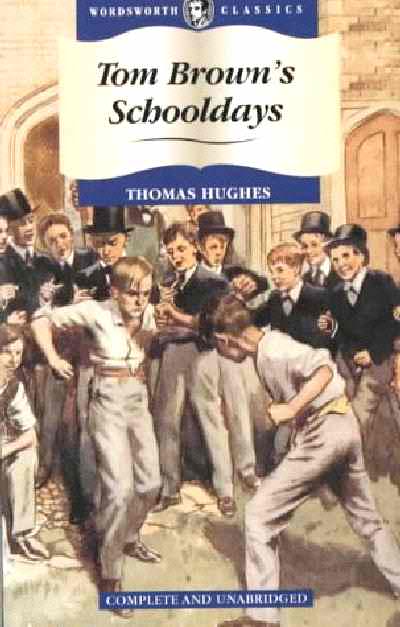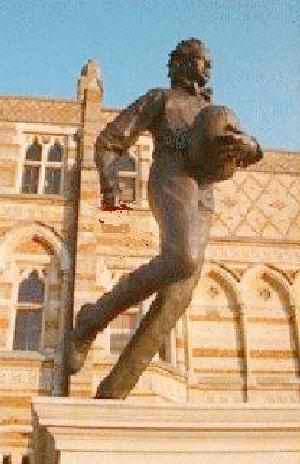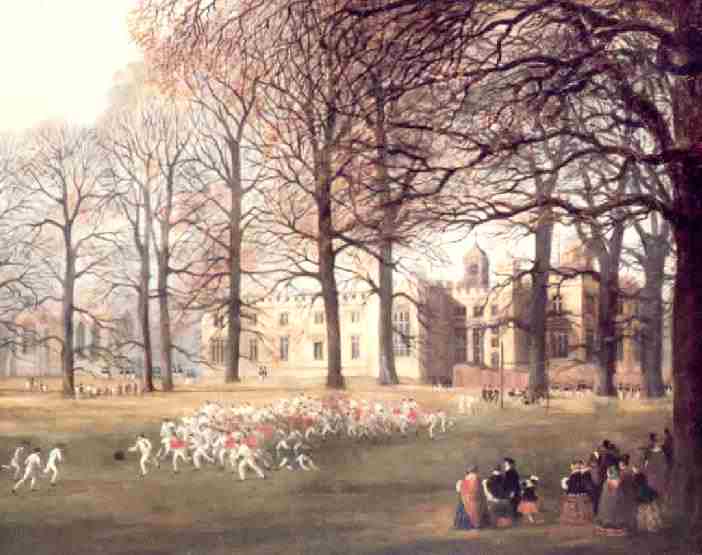
William Webb Ellis: Originator of Rugby Football (1806-1872)

Figure 1.--This school story tells about the friendship of three boys called Tom, East and Arthur. They are boarders who come into conflict with the school bully called ‘Flashman.’ It also depicts life of the boarding school at that time. Rugby was the school William would go to when he was 11. Because accounts of the school in the early 19th century are limited, we can use the Tom Brown account to get an idea what the school was like in the 1820s when Wolliam attended. The school depicted in Tom Brown's School Days was a very rough place, especially for the younger boys.
|
William Webb Ellis is credited by Matthew Bloxam as the originator of Rugby football. This is a remarkable story of a 16 year old boy, from Salford, Lancashire, who played soccer and invented a new ball game called Rugby. Bloxam recalls that this happened in November,1823. It was in the days prior to the Matthew Arnold becoming one of Rugby School’s famous headmaster. Rugby School was and still is an independent boarding school in Warwickshire. This is in the middle of England. The book about the early 19th Century Rugby
School was written in 1858 by Thomas Hughes. He was the first author to write a novel about boys and their adventures in a boarding school. The story is called Tom Brown’s School Days.
This school story tells about the friendship of three boys called Tom, East and Arthur. They are boarders who come into conflict with the school bully called ‘Flashman.’ It also depicts life of the boarding school at that time. Rugby was the school William would go to when he was 11. Because accounts of the school in the early 19th century are limited, we can use the Tom Brown account to get an idea what the school was like in the 1820s when William attended. The school depicted in Tom Brown's School Days was a very rough place, especially for the younger boys. This was the situation at other public schools as well. Hughes book is a fictional account. but is believed to accurately describe school life at the time.
Rugby School
Rugby School was and still is an independent boarding school in Warwickshire. This is in the middle of England. These schools are called public schools in England even thoufg thaeybare exclusive private schools. Rugby is one of the most famous of these schools. The school was founded in 1567 by Lawrence Sheriff, a local resident, as a boys' boarding school. Sheriff was one of the Gentlemen of the Princess Elizabeth (the future Queen), a grocer, and Second Warden of the Grocer's Compoany. The school was endowed with estates in the Rugby area and in London suburbs. The school did not, however, for a variety of reasons, get the full benefit of those endowments until 1653.
William Enters Rugby
When William was 6 years old his family moved away from Salford, a city in the North of England to a town in the middle of England, called Rugby. He was a bright pupil and was awarded a scholarship to Rugby School.
Rugby School Uniform
William's Mother made sure that he had the school uniform. This was top hat, white
trousers, braces (suspnders) , black jacket, white shirt and a tie. He would have worn black leather shoes or boots. He would have looked smart on his first day in 1816. Hughes records amusing stories of how the boys tried to take the newness out of their clothes.
New Boys
Hughes’ book Tom Brown’s School Days tells what it was like on the first day as the boys acquainted themselves with their new surroundings and settled into the school. Tom meets another boy called East. It is the beginning of their friendship. Tom witnessed a
game of Football as played to rugby rules. This is depicted in the 1951 film. It shows a soccer game in the early stages of the games development. It was a game of few rules. The game was played very differently then than now and many more children were involved in its playing. Encarta descibes such play as 'mob games.'
Football Kit (Uniform)
The films and contemporary pictures show how the boys played the game. They are not wearing a football kit instead they are playing in their uniform minus the jacket. A statue of William Webb Ellis shows him playing in his white shirt and tie. Thomas Hughes
wrote thus ‘… at the time we are speaking of plush caps have not yet come in, or uniforms of any sort, except the School-house white trousers.’ The boys appear not to be wearing football boots but ordinary boot shoes. The ball is a round one. It was a pig’s
bladder encased in leather.
The Early 19th Century Game
In the first half of the 19th Century ball games at Rugby and other public schools were played for fun. They were seen as recreational activities which the boys pursued once their lessons were over. Few records exist about these games. Football was a rudimentary game them and each school had their own rules as to how the sport was played. At Rugby they played football on a grass field. Often it was the boys who made the rules. Matches with other schools were not common.
Football at Rugby
There were game meetings called ‘levies’ these were attended by the boys. The meeting place was often under the elm trees. This could be called before a game or after it. The boys discussed whether or not to allow the goals that had been scored. It was at these
meetings that the following rules had been agreed upon. The ball must be caught in the air. The catcher must not be off his side. The catcher had to carry the ball and touch down himself. It was illegal to pick the ball up off the ground. These were the rules in
place at the time William Webb Ellis became a Rugby boarder.
At Rugby football was played on the Close when it was a half- holiday. The whole school turned out when a game was to be played. The boys picked their teams. The best two players would select around 20 other pupils. Their task was to ‘Follow up.’ The remaining
boys were divided up into two sides and they were expected to keep goal. The goal posts were 18 feet high and there was a cross bar 10 feet above the ground. Goals were scored by kicking the ball over the cross bar.
Chapter 5 of Thomas Hughes novel gives a gripping account of the football games played then. Tom is with East they are looking at the goal posts. East explained: "This is one of the goals," said East, "and you see the other, across there, right opposite, under the
Doctor's wall. Well, the match is for the best of three goals; whichever side kicks two goals wins: and it won't do, you see, just to kick the ball through
these posts - it must go over the cross-bar; any
height'll do, so long as it's between the posts.
You'll have to stay in goal to touch the ball when it
rolls behind the posts, because if the other side
touch it they have a try at goal. Then we fellows in
quarters, we play just about in front of goal here,
and have to turn the ball and kick it back before the
big fellows on the other side can follow it up. And in
front of us all the big fellows play, and that's where
the scrummages are mostly."
Later in the story Hughes describes the scoring of a
goal: “Crab strikes his heel into the ground, to mark the
spot where the ball was caught, beyond which the
school line may not advance; but there they stand,
five deep, ready to rush the moment the ball touches
the ground. Take plenty of room. Don't give the rush a
chance of reaching you. Place it true and steady.
Trust Crab Jones. He has made a small hole with his
heel for the ball to lie on, by which he is resting on
one knee, with his eye on old Brooke. "Now!" Crab
places the ball at the word, old Brooke kicks, and it
rises slowly and truly as the School rush forward.
Then a moment's pause, while both sides look up at the
spinning ball. There it flies, straight between the
two posts, some five feet above the cross-bar, an
unquestioned goal; and a shout of real, genuine joy
rings out from the School-house players-up, and a
faint echo of it comes over the close from the goal-
keepers under the Doctor's wall. A goal in the first
hour - such a thing hasn't been done in the
School-house match these five years.”

Figure 2.--The commemorative inscription records the deed in the following way. “This stone commemorates the exploit of William Webb Ellis who with fine disregard for the rules of
football as played in his time, first took the ball in his arms and ran with it, thus originating the distinctive features of the Rugby game A.D 1823.” A statue to William Webb Ellis shows him running holding the ball. This was the moment when Rugby
football was created.
|
New Rules
We come to the historic November day in 1823 which Matthew Bloxam, a fellow pupil, claims that William deliberately broke one of these rules and in so doing inaugurated a new ball game. The boys had gathered on the Close as usual. The sides had been selected. The teams had piled their jackets, hats and braces beside the goals ready for the game to
begin. The game began with a cry of ‘Are you ready?’ This was the signal for the game to begin. That day the game was full of fury and developed into an exciting match as the sides battled for the balls possession and to score goals. There came a point when the ball was kicked high into the air and as it was descending, William ran to catch the falling ball.
He stood still, as did the other players; with outstretched arms he caught it. The other players could not move until Webb Ellis had passed the spot where the ball had been caught.
He could do one of two things. He could go back to where the ball had been caught and kick it wherever he wished. His other choice was to put the ball on the ground and try to score a goal by kicking it over the crossbar and between the goal posts. Ellis did
neither. There is a stone plaque at the entrance to Rugby school. It tells what happened.
Once William had caught the ball he held it tightly in his arms and rushed forwards with it. This was against the rules. No doubt after the match it would have been hotly debated under the elms. The outcome of this meeting would have gone against William and any goal
he scored would have been disallowed. His action that day would have been the talking point of the school. His disregard of the rules would possibly not then have made him the ‘hero of the hour.’ He would have been very unpopular for a day or so.
The commemorative inscription records the deed in the following way. “This stone commemorates the exploit of William Webb Ellis who with fine disregard for the rules of
football as played in his time, first took the ball in his arms and ran with it, thus originating the distinctive features of the Rugby game A.D 1823.” A statue to William Webb Ellis shows him running holding the ball. This was the moment when Rugby
football was created. William’s enthusiasm for football created a new game. This action was not the occasion for an immediate start for a new game; rather it took a while for it to be developed. Before then other boy’s broke the rule and ran forwards holding the ball. This became a very common practice.
Doubters
There are those who doubt Matthew Bloxam’s account but despite it being 50 or so years after the event he believed it was what happened. I think the most important aspect of the story that the game of rugby was originated by school boys. This fact makes it all
the more a remarkable achievement. Thus illustrating the impact children have on historical development and in this case how they influenced the development of a national sport.
For within a short period of time the game became very popular throughout England both for players and as a spectator sport. By the end of the 19th century two versions of the game had emerged Rugby Union and Rugby League. The game spread throughout the world and now
many countries play it. An historical analyisis arguing against Bloxam's account can be found on www.pshortell.demon.co.uk/rugby. I go with the Encyclopaedia account.

Figure 3.--This painting seems to show a game of rugby at Rugby. The artist and sate are unknowm but we would guess about 1850 based on the clothing of the spectators. As the trees are bare and the spectators warmly dressed, we would guess that the painting may have been done in November or early December. Note that there is one child among the spectators. We wonnder if it is a girl watching her brother play or a boy in a kilt and black jacket. It is of course impossible to tell at this distance.
|
Media Depictions
These are the dates of the movies and TV mini-series about Tom Brown's School Days. There was an Americam film of the same title made in 1940 by RKO. The British J. Arthur Rank studio made a film in 1951. There was also a BBC Miniseries in 1972. Sadly no one has ever made a film about William and the beginning of rugby football. HBC does not yet have reviews of these productions yet, but we eventually hope to add them to our theatrical section.
Sources
Hughes, Thomas. Tom Brown’s School Days (1858).
Encarta.
Matthew Holbeche Bloxam articles in the Meteor October 1876 and December 12th 1880.
Ray, R.D.R. Rugby Football.
www.rfu.com (Page about us)
www.visitrugby.com/tourist%20information/william-webb-ellis.htm
Rugbypathwaytofame.
www.gwilly.ca/ellis.html
htlp://web.tiscali.it/no-redirect-tiscali/terzacento/html/ellis.htm
www.geocity.com/analysts-anonymousltea/wwellis.htm
www.p.shortemon.co.uk/rugby
http://r/1908.com/rugby-history.htm
William Eric Ferguson
HBC

Navigate the Historic Boys' Clothing Web Site:
[Return to the Main English individual experience page]
[Return to the Main rugby football page]
[Return to the Main 19th century children in history page]
[Introduction]
[Activities]
[Biographies]
[Chronologies]
[Countries]
[Style Index]
[Bibliographies]
[Contributions]
[Frequently Asked Questions]
[Glossary]
[Satellite sites]
[Tools]
[Boys' Clothing Home]
Navigate the Historic Boys' Clothing Web chronological pages:
[The 1840s]
[The 1850s]
[The 1860s]
[The 1870s]
[The 1880s]
[The 1890s]
[The 1900s]
Navigate the Historic Boys' Clothing Web style pages:
[Dresses]
[Suits]
[Vests]
[Knickers]
[Caps]
[Socks]
[Neckwear]
[Collars]
[Strap shoes]

Created: March 28, 2003
Last updated: March 30, 2003




